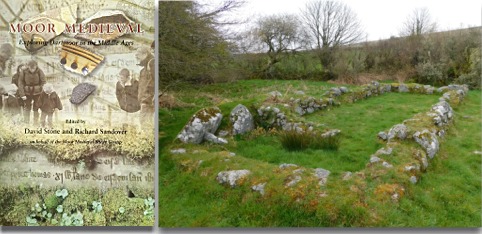
Every now and again a new book about Dartmoor is published which can be described as having that WOW factor and sits in the ‘can’t put it down’ category. ‘Moor Medieval‘ is one that certainly deserves that accolade. Published by the Moor Than Meets the Eye Landscape Partnership in conjunction with their Moor Medieval Study Group the book was supported by the National Heritage Fund along with other local groups and organisations. I occasionally get asked to review some Dartmoor books but when this one arrived my first thought was – where do I start? There are so many fascinating aspects to ‘Moor Medieval‘ that to do it justice would take a book in itself.
I think it would be fair to say that if you asked people to name a landscape feature from Dartmoor’s past many would reply, Merrivale, Bellever, Grimspound and other such prehistoric sites. A few would answer the Houndtor settlement or may be Uppacott longhouse but how many would elect for the other medieval sites to be found on the moor? But why should that be? Looking at my extensive Dartmoor library I would suggest that the answer lies there, up until now there has not been a book specifically focusing in-depth on the medieval period. I would also suggest that many of the places in various guide books which are recommended to visitors also neglect this important period of Dartmoor’s history, again ‘Moor Medieval‘ redresses that imbalance.
Firstly the book – It is A4 in size and comprises of over 180 pages and consists of six chapters which examine and discuss the following; Approaching Medieval Dartmoor, Recreating the Medieval Landscape, 1000 – 1239, Before the Black Death, 1239 -1348, The Black Death and its Aftermath, 1349 -1400, The Later Middle Ages, 1400 – 1525 and People, Landscape and Communities. The book focuses on the development of six parishes through the Medieval period and covers Chagford, Gidleigh, Manaton, North Bovey, Widecombe and the adjoining areas of the Dartmoor Forest. Within each chapter are numerous ‘boxes’ which spotlight various associated aspects relevant to each chapter, each one written by members of the ‘Moor Medieval Study Group’. Throughout the Moor Medieval there are numerous photographs, maps, diagrams, tables and document extracts, all which come together to create a new narrative of this important period of Dartmoor’s history. As one would expect of a book of this standard there is a comprehensive bibliography and content index. Amongst those who have contributed to this project are eminent archaeologists, historians, landscape historians, a Building Conservation Officer, a Historic Buildings Officer and a host a other experts in their field along with numerous volunteers.

What makes the medieval period so exciting and dramatic is that it is possibly the earliest period of Dartmoor’s history where a wealth of documentary records, buildings, material culture and the very landscape exist. Throughout the period those living on the moor faced many challenges such as famine, the Black Death and climate deterioration all of which are discussed within the book. Particularly interesting is the coverage of the recent North Hall excavations along with the development of Widecombe in the Moor and Gidleigh Manor along with the spread and effects of the Black Death. Have you ever heard of Blackefurses? I must admit I never had until reading the book and its section on the search for this abandoned settlement. Even more impressive and indicative of the whole book was the use of the modern investigative techniques amongst which is the use of LiDAR or 3D scanning to produce evidence for the Blackfurses search.
Conclusion – For anyone interested in the Medieval period of Dartmoor ‘Moor Medieval‘ is just not a ‘would like’ but a ‘gotta have’ publication. I have only two small criticisms which are the fact that it would have been interesting to see rather more examination of place-names (but that is because it’s a pet subject of mine). Secondly it would have been useful to include some Ordnance Survey grid references for the various locations discussed in the book. Having previously purchased similar historic books, another criticism if you can call it such, is that the book is way under-priced which not only makes it a fascinating read but a real bargain not to be missed.
You can purchase your copy by contacting West Country Books in Newton Abbot – follow the link to the book – HERE

 Legendary Dartmoor The many aspects past and present of Dartmoor
Legendary Dartmoor The many aspects past and present of Dartmoor

An update on where you can buy a copy as I have now left my job at DNPA! Westcountry Books in Newton Abbot are selling Moor Medieval online – you can purchase directly via this link
https://www.abebooks.co.uk/servlet/BookDetailsPL?bi=30906915655&searchurl=bi%3D0%26ds%3D30%26sortby%3D17%26tn%3Dmoor%2Bmedieval%26vci%3D54458028&cm_sp=snippet-_-srp1-_-title1
Emma Stockley